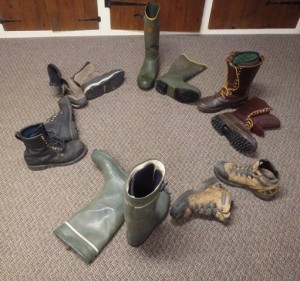Enjoy Winter! The Feet – Part II
by Tim Burris, Mariton Preserve Manager
Comfortable footwear starts with socks, especially in the winter. Warmth is something we want from our socks in the winter. If your feet are dry they will also be more comfortable. So, we want socks that wick away moisture when our feet sweat during activity, and also insulate.
For me it is wool. I wear ragg wool socks in winter and summer. Wool keeps my feet dry and insulated, whether it is cold or hot. Besides my everyday wool socks, I keep merino wool socks in different weights and heights. For extreme cold, stationary activities like ice fishing, stand hunting, or wildlife watching I will don a pair heavy-weight knee-high merino wool socks. (Knee socks add an extra layer on my calves that warms circulating blood.)
I truly feel sorry if you are allergic to wool, because it is an unbelievable material. If you are just wool averse, you should check out some wool products again. If you haven’t tried wool in some time, Merino wool is much softer than you might imagine. (I’ve been told alpaca wool is even softer.) Some manufacturers weave merino into a pile-type fabric that is really soft. Filson, Smart Wool, and Ullfrotte are three manufacturers that use this type of wool fabric for socks and thermal underwear. There are also wool/synthetic blends that might work for some people. Wool products can be expensive, but wool wicks moisture away from your feet and provides insulation, (everything we want in a sock). And it is a renewable resource!
If you can’t wear wool, alternatives would be some type of synthetic (fleece, polypro, acrylic, etc.). You could use a thin silk (a natural product) liner under any of these other materials. (I feel silk wicks away moisture better than the synthetics, but that may vary for you.) There are a new (to me) array of synthetics now, and I still don’t have a favorite. So, you are going to have to experiment to find what works best for your feet. One thing to remember: cotton socks are bad for winter activities. Cotton holds moisture against your feet, and actually transfers heat away from your body – making your feet wet and cold. Brrrrrrr. Another no-no is wearing so many pairs of socks that the circulation is cut off to your feet in tight fitting boots.
If I am moving, I usually don’t have a problem with cold feet. If I am stationary for a while my feet will begin to feel cold. (Think plowing snow on the tractor for long periods.) If you have chronically cold feet, or plan to do stationary activities, try chemical heat packs. Toe Warmers are shaped specifically to the task, and stick to the bottom of your socks. I have found them to be a boon in the few pursuits where my feet do get cold.
I’m the Imelda Marcos of boots. (The photo above is just a selection of boots I might wear in the winter depending on conditions.) Your boots should help keep your feet dry from the elements outside. In the winter, I also want a boot with moderate insulation (200 – 600 grams). I like removable liners, but also have boots with built-in insulation.
You can make your regular hiking boots into winter boots with a couple accessories. First off, waterproof them again (even if they have a waterproof liner such as Gore-tex). A pair of gaiters will keep snow out, and keep the uppers dry. Gaiters also keep feet warmer by adding another layer of insulation. Are your boots slipping in the snow? Try snow shoes, or check out these recommendations in The Feet – Part I.
Take care of your feet. They get us around. Our feet are the farthest thing from our heart, and thus the first thing to get cold. If you can keep your feet warm and dry you will find it much easier to enjoy winter.

